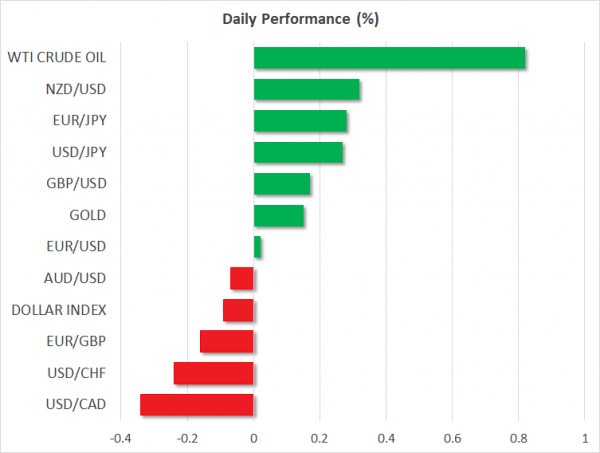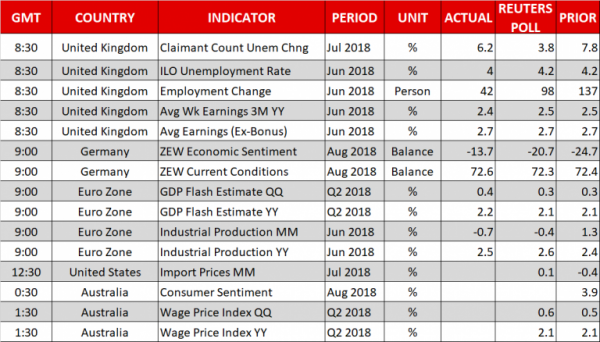Here are the latest developments in global markets:
FOREX: The US dollar index, which measures the dollar’s strength against six major currencies, declined by 0.13%, while dollar/yen inched up by 0.23%, trading near the 111.00 psychological level. Euro/dollar started the day in the green but quickly dropped its gains and is down by 0.07% on the day despite an unexpected upward revision in Eurozone Q2 GDP growth estimates. Pound/dollar managed to rebound after the UK’s unemployment rate surprisingly fell to 4.0%, while analysts anticipated the rate to stand flat at 4.2% in June. However, wage growth readings (including bonuses) accompanying the employment numbers came in slightly lower than expected at 2.4% y/y in the three months to June, constraining the pound’s recovery. Pound/dollar was last at 1.2775 (+0.07%), trading around near 13-month lows. Of note, Brexit negotiations will resume on Thursday. The lira rebounded today after hitting a record low of 7.21 per dollar on Monday as the Turkish central bank took some steps to enhance liquidity. However, the Turkish president’s trade threats against the US (see below) are likely to continue exerting pressure on the currency. Meanwhile, aussie/dollar is set to post the fourth consecutive red day (-0.10%), approaching again the 18-month low of 0.7247, whereas kiwi/dollar is paring some losses from previous days, adding 0.27% to its daily performance. Dollar/loonie fell by 0.35% to slip below the 1.3100 handle.
STOCKS: European equities traded higher on Tuesday, as worries over the US-Turkish political turmoil took the back seat for now after the Turkish central bank announced some measures that appear to ease worries to an extent. The pan-European STOXX 600 and the blue-chip Euro STOXX 50 were up by 0.29% and 0.43% respectively at 1030 GMT despite financial stocks remaining in the red. The German DAX 30 advanced by 0.23%, while the French CAC 40 climbed by 0.21%. The Italian FTSE MIB rose by 0.25%, while UK’s FTSE 100 was down by 0.08%. In the meantime, futures tracking major Wall Street indices were in the green, pointing to a positive open.
COMMODITIES: Oil prices headed higher today on news Saudi Arabia had cut production in July. Nevertheless, OPEC’s lower demand projections for 2019 on the back of worries that rising trade uncertainties could weigh on economic growth kept investors somewhat cautious. WTI crude oil climbed by 0.98% to $67.86 per barrel, while London-based Brent advanced by 1.0% to $73.34 per barrel. Gold prices moved higher by 0.14% to $1,194/ounce, rebounding from the fresh 20-month low of $1,191.35 posted on Monday.
Day ahead: US-Turkish relations to remain in focus; Australian wage growth and Westpac economic sentiment eyed
Although the risk-off sentiment linked with the Turkish story seemed to soften a bit on Tuesday, investors will continue to monitor developments around the US-Turkish standoff as a top national security aide to the US President said on Monday that negotiations will not take place between the countries until Turkey frees the detained American pastor. On Tuesday, the Turkish President, Tayyip Erdoğan, threatened to ban electronic products from the US to punish Washington for the lira’s meltdown. This is a signal that the dispute could hold for longer and therefore the euro could find it hard to recover in the following days amid worries that the lira’s meltdown could have negative implications for the European banking sector.
Turning to the economic calendar, US import and export prices will provide a piece of evidence on inflationary pressures later in the day at 1230 GMT, with analysts projecting the former to rebound by 0.1% in July on a monthly basis after posting a decline of 0.4% in June, while the latter is expected to slow down from 0.3% m/m to 0.2%.
Following the above US data, the focus will turn to Australia early on Wednesday, where the Bureau of Statistics is scheduled to publish wage growth figures for the second quarter at 0130 GMT, a key factor behind the RBA’s accommodative monetary policy. While the central bank is eagerly awaiting for subdued wage growth to pick up steam before it decides to remove some stimulus, the data are expected to show that earnings have expanded at 2.1% y/y, the same as in the previous quarter. On a quarterly basis, though, the measure is forecast to rise slightly faster than in the March quarter, posting a growth of 0.6% compared to 0.5% seen previously. Should the numbers beat expectations, turning RBA policymakers more confident on the economy’s outlook, the aussie could recover losses made in the past few days and vice versa. Additionally, Westpac’s consumer sentiment index for the month of August delivered prior the wage numbers at 0030 GMT could also move the aussie.
Meanwhile in oil markets, the American Petroleum Institute (API) will publish its weekly report on US crude oil inventories at 2030 GMT, with scope to add some volatility to crude prices.















